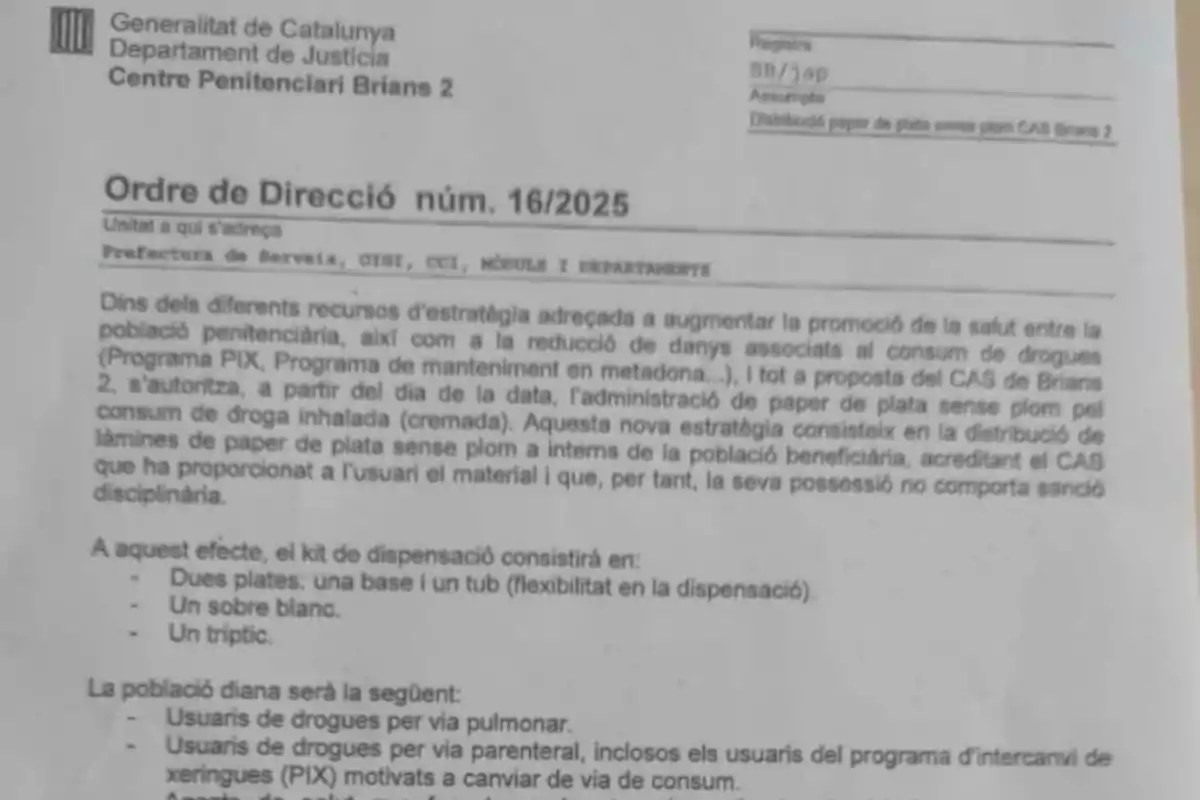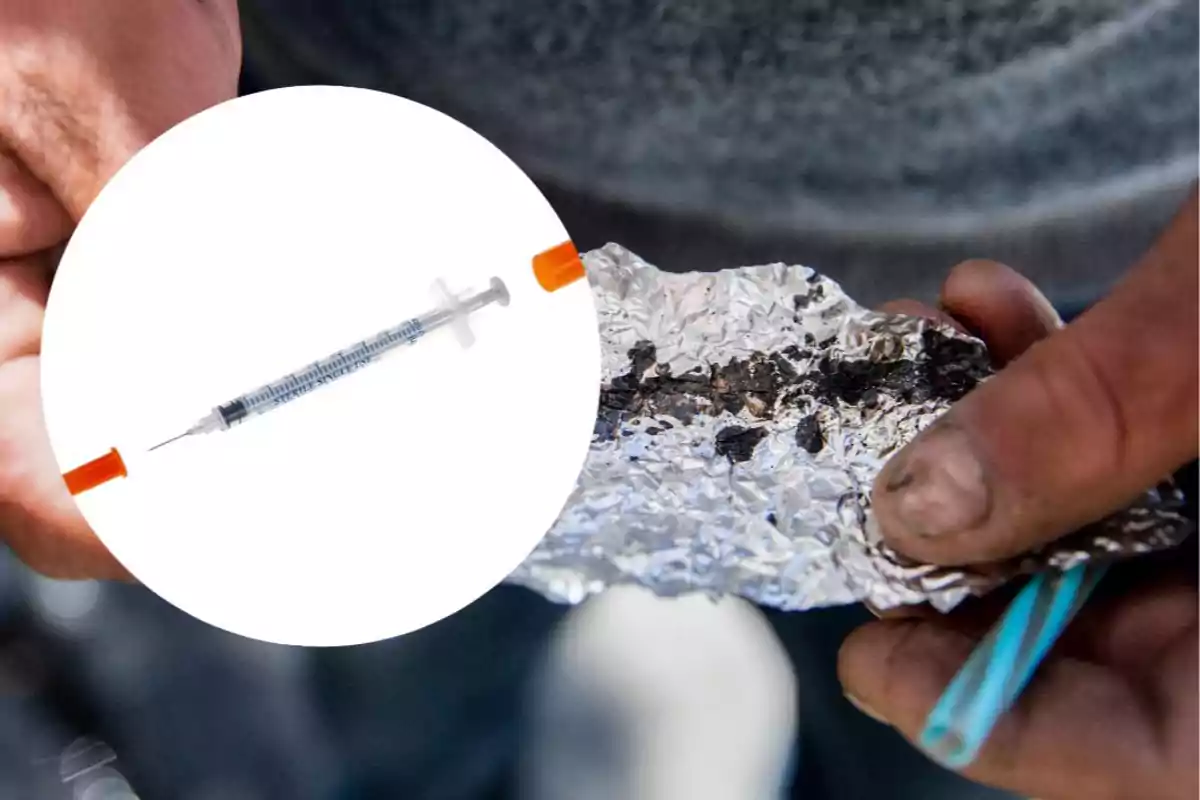
Drug chaos in prisons: why Catalonia gives aluminum foil to its inmates
Amid the wave of drug-related infections, Brians 1 and 2 prisons distribute hygiene supplies to addicted inmates
The shadow of drug-related infections once again looms over Spanish prisons. After the drama experienced in the 1980s and 1990s due to the rise of drugs in prison, the penitentiary system is reactivating an old strategy.
Although it may seem like a controversial solution, it already proved its effectiveness back then. The strategy is to distribute hygienic materials to reduce harm. This time, it's not syringes, but aluminum foil. The goal: to encourage inhaled consumption among inmates with addictions and to avoid intravenous use, which is the most dangerous in terms of public health. Penitentiary sources confirmed this to elcierredigital.com.
The penitentiary center of Brians 2, in Sant Esteve Sesrovires (Barcelona), began distributing kits this June. They give aluminum foil to inmates who use heroin and other smoked drugs. The measure has already been implemented in Brians 1 since 2020 through the program "Fumando en plata." This is part of a harm reduction strategy promoted by the Department of Justice of the Generalitat.

The kits contain lead-free aluminum foil, a rollable tube, and a leaflet with instructions to reduce risks. They are only distributed under medical supervision from CAS (Drug Addiction Care and Monitoring Center) and with clear clinical criteria. "They are not distributed generally nor do they represent a blank check to use drugs," the administration insists.
The core of the measure is health-related. Inhaling drugs like heroin with aluminum foil involves less risk of infections than injecting with shared syringes. In prison, where access to sterile materials can be limited or clandestine, sharing needles has historically been a source of transmission.
Additionally, the aluminum foil that is usually used in these cases contains lead, which is even more harmful to health. That's why the kits are supplied with lead-free foil.

In the 1980s and 1990s, heroin wreaked havoc in Spanish prisons. Forty-six percent of inmates admitted in 1988 admitted to having used intravenously, and one in three tested positive for HIV.
Hepatitis C, even more contagious, was rampant. Prisons became spaces of silent infection, where poverty, marginalization, and drug addiction combined in a lethal cocktail.
The response arrived in the 1990s with the distribution of bleach to disinfect syringes, condoms. Finally, the pioneering needle exchange program was launched at Basauri prison (Vizcaya) in 1997. It was a turning point. Spain became a European reference in harm reduction within the penitentiary environment.
From Syringes to Aluminum Foil
Three decades later, the approach is adapting to new realities. Instead of fighting against consumption—something that penitentiary authorities themselves acknowledge is very difficult to eradicate—the health strategy focuses on minimizing risks. That's where aluminum foil comes into play.
In Brians 1, the pilot program began in 2020 and has been evaluated in a study published by the CAS team at the center. In this study, 18 inmates (men, women, and one trans woman) were interviewed. They highlighted that the material provided was much safer than what they improvised on their own. They used yogurt lids, burnt cardboard, or tobacco wrappers.

The inmates stated that smoking heroin with lead-free foil reduced the bad taste, coughing, irritation, and stench, as well as decreasing the frequency of overdoses. Some even stated that they had completely abandoned intravenous use and were more willing to access treatment programs.
A Problem More Alive Than Ever
Far from being a memory of the past, the drug problem remains fully present in Spanish prisons. In Catalonia, it's estimated that 40% of inmates suffer from some type of drug addiction. The entry of narcotics into prison, despite controls, continues to occur. Consumption methods, when unsafe, become a vector for disease transmission.
With this measure, authorities aim to prevent a repeat of the health crisis of the late twentieth century. The Department of Justice keeps that this policy is in line with harm reduction strategies already present in the community. Outside prison, materials for safer use are also distributed to addicted individuals who have not yet been able to quit. Prison can't remain on the sidelines.
Is Consumption Being Normalized?
However, not everyone agrees. Some unions of penitentiary officials criticize that this policy can be interpreted as a way to normalize consumption in prison. They argue that it blurs the rehabilitative function of the institution and sends a contradictory message: on one hand, drug entry is pursued, and on the other, materials are provided for their use.

In response to these criticisms, program managers insist that the intervention is highly controlled. It's applied only to inmates under medical supervision, and its goal is to prevent greater harm, not to encourage consumption. They also point out that contact with CAS can facilitate inmates' entry into detoxification and therapy processes.
Public health experts recall that similar measures, such as syringe distribution in the 1990s, also caused controversy at the time. However, the data supported their effectiveness: the HIV rate in Spanish prisons dropped from 30% to less than 5% in two decades.
Beyond Catalonia
For now, the distribution of kits is limited to Brians 1 and Brians 2, but the program's success could extend it to other prisons. Some autonomous communities with penitentiary powers are watching closely. Others, such as those still dependent on the Ministry of the Interior, may take longer to adopt similar measures due to political or strategic reasons.
The truth is that Spain remains one of the countries that has advanced the most in prison health policies, at least in terms of harm reduction. The experience of the 1990s showed that accepting the reality of consumption inside prison is not surrender, but a way to prevent deaths and infections.
Now, with the return of drugs like heroin and the rise of new substances such as crack or fentanyl, authorities are once again forced to adapt. In this silent battle for the health of the most vulnerable, a simple piece of aluminum foil can make the difference between life and death.
More posts: